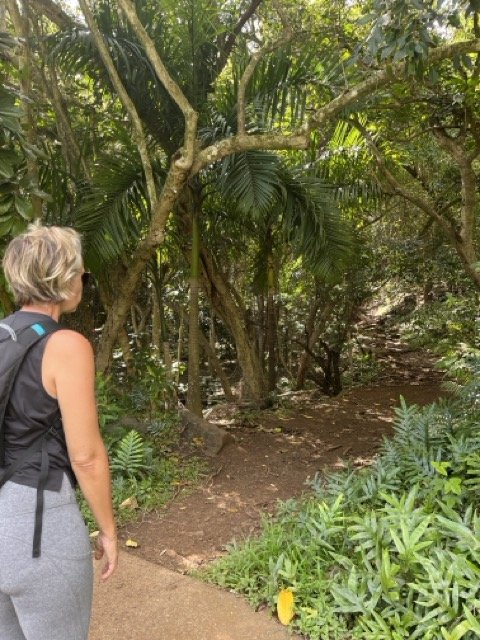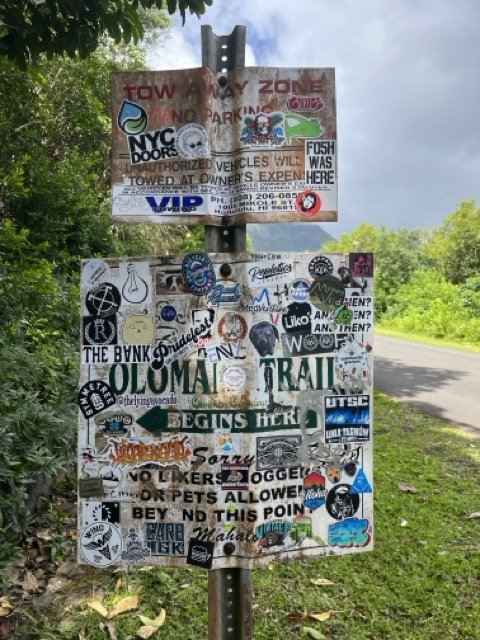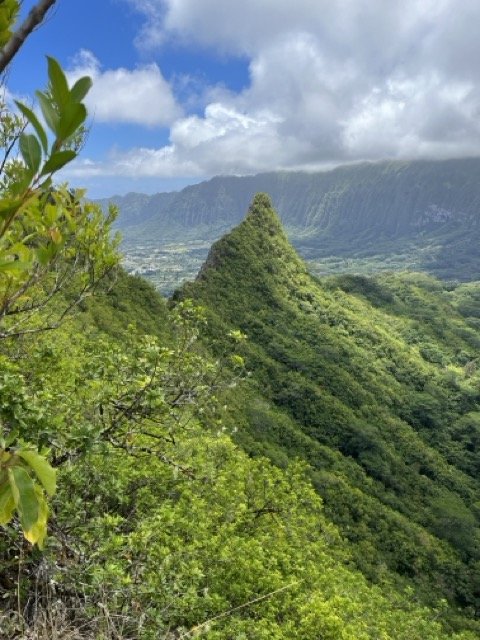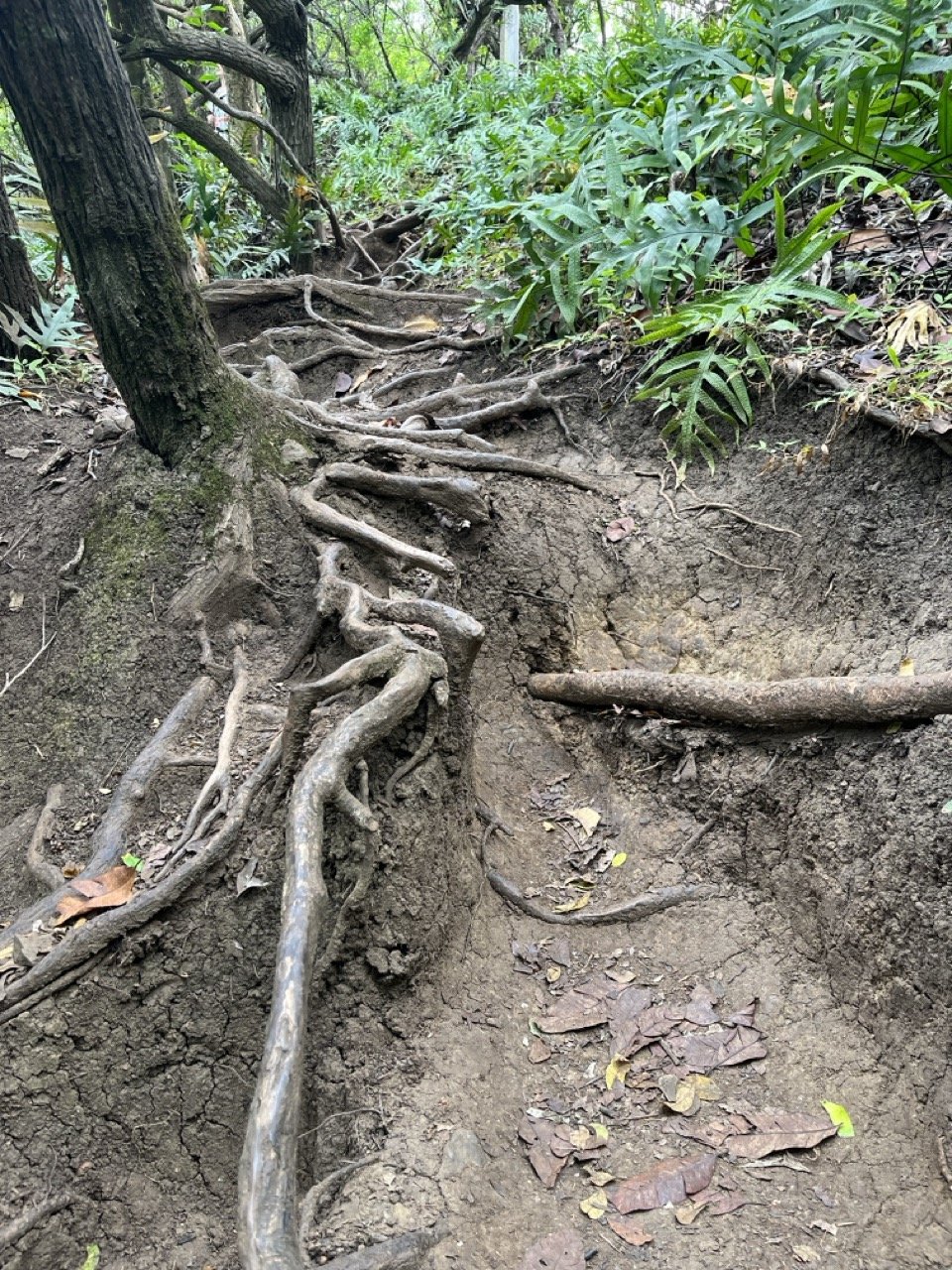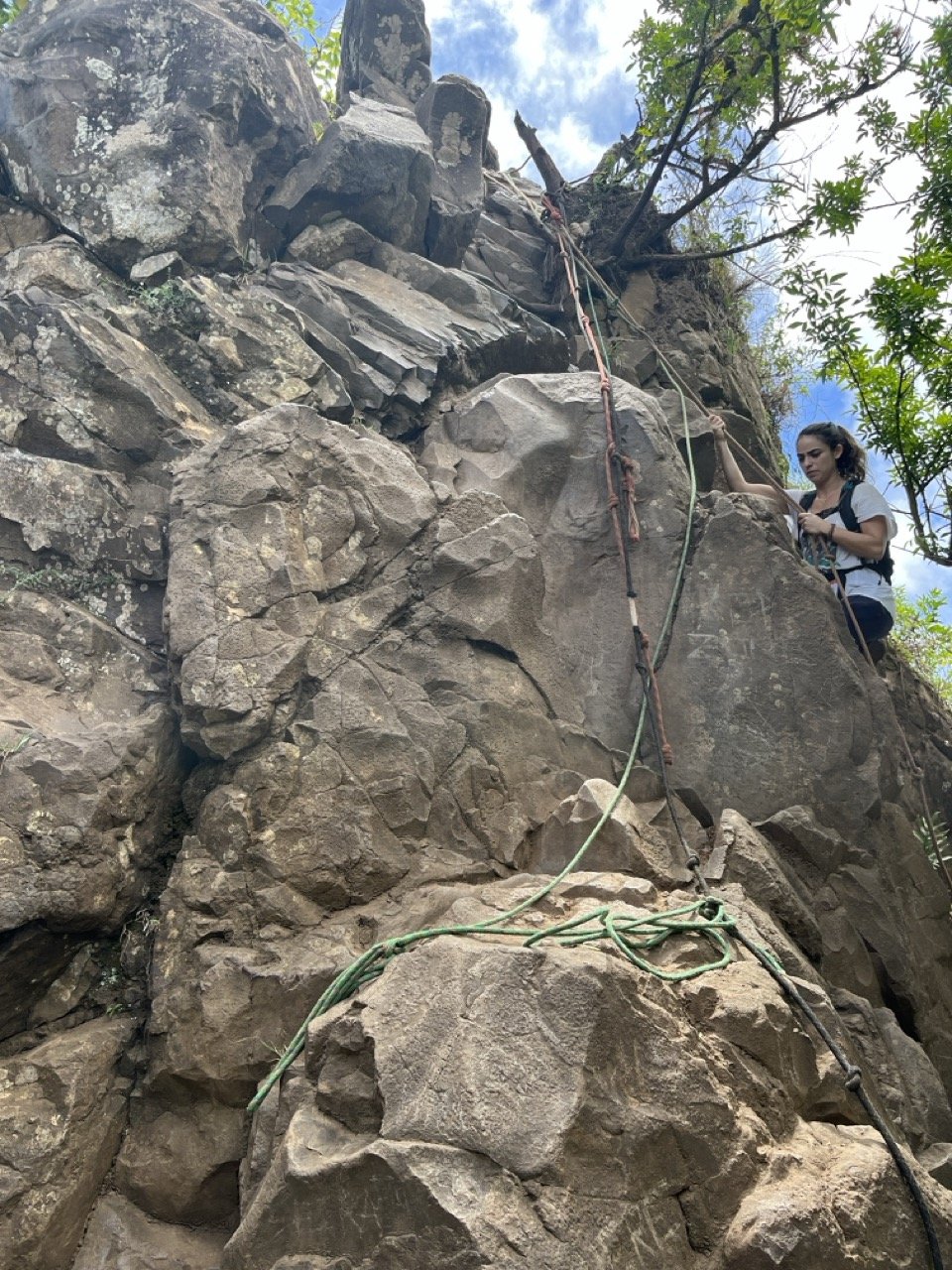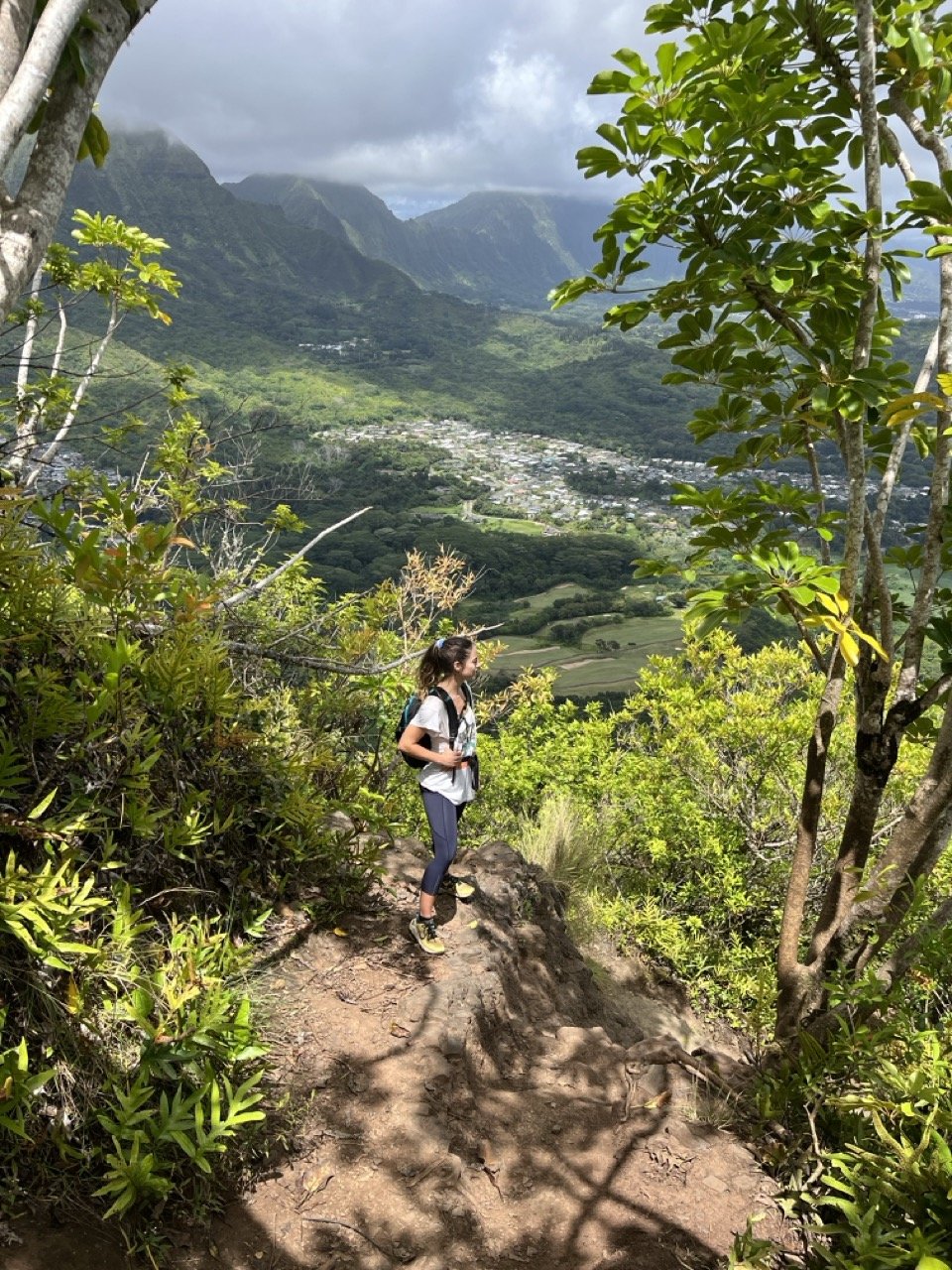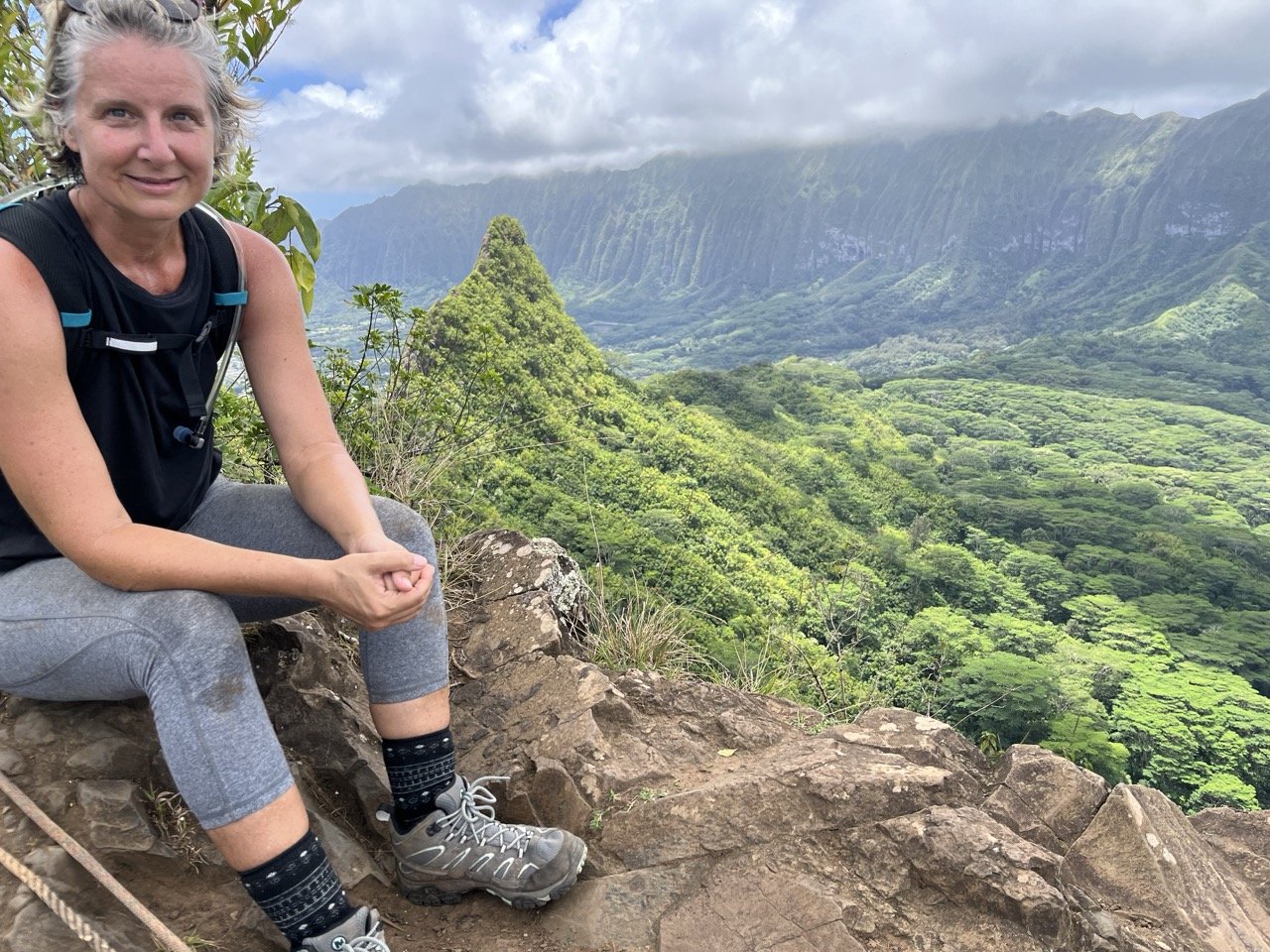BOOK 2
Prologue
HANDS FULL OF AIR
Mt. Olomana Trail (“Three Peaks”)
O’ahu Hawai’i
April 28, 2022
I got it in my head I needed to hike Olomana.
Now, for that sentence to strike terror in your heart, which is the response I want, I will need to explain. The Mt. Olomana Trail is actually a series of three treacherous peaks on a mountain that stands anterior to the Ko’olau Range on the Windward side.
Technically speaking, Olomana refers only to the first of the three peaks followed by Paku’i, the second, and Ahiki, the third. Combined, this string of rocky outcroppings offers up spectacular views from Kailua to Makapu’u while also keeping Search & Rescue helicopters hovering like hummingbirds. Missing and injured hikers are common and in the last decade, there’s been six confirmed fatal falls.
Yep. You heard me right.
Six people have died on that mountain.
And half of them were NOT tourists.
The challenge of hiking Olomana has been compared to skiing a double black diamond slope and AllTrails has gone so far as to issue an uncharacteristically strong warning on the hike’s landing page saying:
USE CAUTION: many hikers have died on this hike. If it is rainy, do not go. The entire hike can be dangerous but it is far more perilous after the first peak. If you’re not an experienced hiker this is not the trail for you. You vertically scale the side of a mountain holding onto ropes for life. If the weather turns, even experienced hikers could be in a life threatening situation. By the end of the route you are no longer hiking, you are on a technical 4th class scramble with rope handlines all the way up. For your own safety and the safety of those in your group, consider another hike.
I fully support their fear-mongering.
Olomana is not a recreational hike. It is, instead, a Class 3 mountain with some experienced hikers cautioning that it’s really a Class 4 with Class 5 passages on Ahiki. But maybe you aren’t familiar with the classification system and so you are still not properly terrified for me.
Here’s why you should be:
Let’s say a Class 1 trail is a low-risk hike on a well-marked trail where you won’t need any technical gear beyond your boots and a day pack. Sneakers might even suffice and you can probably bring the kiddos. Hooray.
Then there’s a Class 2 trail, which may be rated as a Easy or Moderate. The unsteadiness of the trail comes from scree or talus, tangled root systems and elevation gains. You may need a map or a GPS to deal with poorly marked switchbacks but no other technical gear is required. Some trails may have railings and stairs already stationed for support. Again, hooray!
But now, we’re getting into the trickier terrains…
A Class 3 trail denotes rugged conditions with steep slopes, large rocks, and extreme scrambles requiring the use of your hands or ropes (or some combination of both) to summit. The exposure factor is higher, meaning there is little to no protection from a fall if you slip so…good luck.
Class 3’s are in my wheelhouse but like I said before, experienced hikers consider Olomana a Class 4 and Class 4 is where we criss-cross from hiking into mountaineering. Unstable terrain and a high level of exposure warrants the use of ropes, harnesses, belay systems and the ability to use the gear safely. The consequence of a misplaced foot or fall is injury or death.
Class 4’s scare the shit out of me and as for a Class 5, that’s the full transition to technical rock climbing requiring the whole shebang - ropes, harnesses, belay, helmets, hardware, trained climbing partners. A Class 5 is not on my agenda for spiritual development, physical training, adventurous storylines or frankly, any other reason.
So I’m not sure why I thought hiking all three peaks should be part of my healing journey or why I tried to turn Olomana into a quest, or rather a marker of my strength and bravery, a mountainous metaphor of my spiritual progression.
Actually, that’s a lie. I do know why.
ALL of my hiking buddies had already “done” Olomana and I’m pretty sure Jeff did it barefoot, or at night in the pitch-black wearing flip-flops or some such nonsense, because Jeff is recklessly fearless, and I was feeling like a scaredy-cat that needed to prove herself. I’d climbed Palccoyo and descended Huyana Picchu with no problems. I’d run a Spartan and finished alive. I figured I could handle Olomana.
I was wrong.
I went to Olomana with my ego in hand.
And she let me know right quick - she was not having it.
Before we even got to the trailhead, I was hot, thirsty and tired.
There is no parking at Olomana. You have to find a spot in a nearby neighborhood, pray you don’t get ticketed and put in your bonus miles walking to the trail. Fortunately, my hiking buddy for the day, Nicole, lived relatively close so we used her house as home base.
Nicole is an excellent hiking buddy. She prepares delicious snacks, enough to feed a small army, and is indefatigable on a trail. When we trained for the Spartan together, she’d often skip backwards up an incline while animatedly relaying the deets of her latest dating disaster as I huffed and puffed, nodding with sympathy, unable to speak or keep up.
Perky. The woman is perky.
She’s also twenty-plus years younger than me which means whenever we train or hike, she’s essentially agreed to drag my Honu Mama ass up a mountain, no matter how long it takes. We are The Tortoise & The Hare. Her patience with me verges on saintliness. Her “You Go, Girl!” positivity keeps me plowing ahead as we bear crawl through wet sand or swing twenty-five pound kettlebells under the noonday sun.
It was a good thing she was with me on Olomana.
After locating the sticker covered trailhead marker past the entrance of the Royal Hawaiian Golf Club, it did not take long for the trail to go vertical…and stay vertical for a mile and a half. I struggled immediately. Feeling winded and nauseous, my turtle pace slowed to sloth. I sucked from my camelback, thinking I was dehydrated. It didn’t help. Everything felt heavy. My body. My legs. My heart. My soul. Something was wrong. Off.
My mind kept doing the math. Olomana has an elevation gain of about 1,600 feet. Palccoyo STARTS at 16,000 feet. Ten times the elevation. I aced Palccoyo. There was absolutely no reason for me to be struggling on Olomana.
But I was.
Finally, a mile up the trail, I gave up and sat. For the first time in almost a year of training and six months of dedicated hiking, summit be damned, I was done. I was sick to my stomach. Woozy. As if I was wrapped in a blanket of fear. Suffocating. I just wanted to go home.
There is usually a moment, during hour two or three of a big hike, where my brain tries to talk me into quitting. “You don’t need to finish this, you’re good. You’ve gotten your exercise. You saw some trees. It’s not about the finish, it’s about the journey…” Crap like that.
This was different. This was my body shutting down. Not allowing me to continue. I was so in judgment of feeling weak and old and slow in that moment, I could not even hear what my body was trying to tell me.
There was death on that mountain.
That’s what I was feeling.
Two weeks before Nicole and I laced up in her driveway, a thirty-year-old volleyball player from Indianapolis fell over two-hundred feet near Ahiki, the third peak. It took sixteen firefighters, forty-five minutes to reach him. The trauma of the fall took his life but the energetic signature of his distress remained.
That’s the only way I can describe what I felt on that trail.
Like something terrible was about to happen.
Like I might die too.
Nicole unleashed her army of snacks and got me back on my feet. Sugared up and ignoring all the somatic cues swirling through my body, I pressed on, headed for the first peak, Olomana, not really understanding what would be required once we got there.
Up until that point, the hike had been mostly ground work - a decently wide trail shaded by lush vegetation and a pretty little section of pine trees. Now, higher and drier, things got rockier, roots snaking through the crevices, we were on our hands and knees, scrambling to ascend. Another half mile of hard work and finally, we made it to the first peak, a vertical wall of stacked boulders that Nicole navigated with the ease of a bouncy billy goat. Perky, perky, perky.
I just stood at the base of that peak and stared.
I wasn’t evaluating my odds of a successful ascent.
I was calculating whether I’d survive getting back down.
Going up is never the issue for me. Up a mountain, I’m focused on the task at hand (meaning ACTUALLY in my hands), the rocky scramble, the overhead branch, the muddy stair. Going up always feels (and usually is) safer than coming down. Coming down, I can see the drop offs, the danger - my brain plays tricks - vertigo, depth perception, anticipation of a fall. Steps look steeper. I often hesitate and overthink. My thighs burn and my legs shake from fatigue.
I always announce to Nicole on our descents, “This is the time when injuries happen.” We’re often tired and just want to be done. We have an inclination to rush, get back in time for Cecilia’s school pick up. But the rocks are no less jagged, the vines are no less trippy, the mud is no less slippery on the way down than they were on the way up. In fact, weather and foot traffic may have made them worse. We can’t relax our concentration just because it feels like the hike is over. It is not over. We are only halfway home.
Nicole’s gotten used to my Mama Bear safety lectures and my fear of descents. She knows she has to kick the cheerleader optimism into overdrive and quite literally, talk me down off a ledge or a boulder or, in the case of The Spartan race, some terrifying A-frame metal scaffolding and rope contraption that scared me so badly my legs shook.
I wasn’t yet shaking on Olomana but I was definitely wary, sizing up the seriousness of my situation. I hadn’t moved in a few minutes. Standing atop the first peak, Nicole shouted down her raspy-throated words of encouragement, “You got this, girl!”
And I believed her.
I approached the rock wall and took the ropes in hand, gave them a testing tug and felt assured they were securely fastened to the rock. I placed one boot on the lowest rock and took a breath:
I could do this.
I could totally do this.
There’s a story in our family, about how Mamaw and Papaw met. Cecil drove an ice truck for his dad and very early one morning, he fell asleep at the wheel and drove off the side of a cliff. Miraculously uninjured, he abandoned the truck, climbed up the cliff then walked several miles to their nearest customers, a small family owned market, to get some help.
Knowing the owners well, Cecil sauntered in and grabbed an apple from a bin, took a big bite - without paying for the produce. That’s when he saw Hattie glaring at him from behind the register. Story goes he took one look at her and announced, “I’m gonna marry that girl.” To which Mamaw always responded, “I thought he had some nerve.” Papaw was a hard worker, handsome and quietly determined. He smoked cigars, was a sharp dresser, fiercely loyal, and he had his own car.
He was, as they say, a good catch.
But Mamaw put him through it.
Every Sunday, Cecil would patiently sit in front of the church, waiting for Hattie to come out so he could drive her, and her sisters, home. It’s the only time she’d see him and she told him, in no uncertain terms that he could keep his cigars but they would not marry until he “became a Christian.” Eventually, he stopped sitting in his car and joined her in a pew.
They were married for over fifty years.
When I shared this family legend in my playwriting class at NYU, my teacher, Len Jenkins, pointed out the obvious - that Papaw walked into that market after surviving a near fatal crash, keenly aware of his own mortality. He was, as we dramatists say, “entering the scene with a strong backstory, heightened emotionality and crystal clear motivation.” Cecil was alive. Exclamation Point. His love-at-first-sight pronouncement was also a glorious declaration of his survival, a claim on his future. A second chance to do things differently.
Len’s astute dramaturgical analysis shifted my perspective entirely, reducing Papaw’s “magical knowing” into a trauma-induced limbic response. It could have been anyone standing behind that register, glaring at Cecil but that morning, it just happened to be Hattie.
This is the big secret that writers know.
That we humans are simply neurotic head-cases being dragged around in flesh suits by our limbic impulses. Our choices and behaviors are governed more by childhood wounds than by logic and no matter how much money we’ve spent on therapy, when shit goes south, we will instinctively grasp at the familiar to feel in control.
Meaning isn’t inherent in a moment. It comes after the fact. When the structural elements - such as characters and setting - have been transformed into a narrative “plot” - a sequence of “relevant” events devised and presented by a writer to flow like a seamlessly, interrelated chronological sequence.
It’s manipulation.
Writing is a magic show, an illusion that relies on humans wanting to transcend their humanness. Writers know you NEED to believe Tom Cruise can scale a building using only dental floss and Superglue, that cars can be both fast and furious, that there is wisdom and evil in a galaxy far, far away. Story offers up both cathartic release and glimmers of hope.
We all need that.
We all need my Papaw to walk away from his crash and into the arms of the only woman who was EVER meant to be his wife because it creates a visceral, somatic response in our bodies. It strengthens our belief that love is instantly recognizable. It proves that there’s a higher order and a reason for our suffering. That life isn’t random. Bad things eventually lead to good. A car wreck turns into a marriage.
Plus, it just makes us feel all warm and fuzzy.
You know, like taking X.
So I understand, dear reader, that at some point during this seemingly endless, multi-book account of my sad widow tale, you’re gonna want me to fall in love. You’re gonna need me to transcend my grief and rise from the ashes like a Phoenix, open-hearted and building anew. With every sentence, there is a prayer brewing inside you: may she overcome. May love save the day. May she please, for the love of God, stop dating military dudes on Hinge.
(Trust me, I join you in that prayer.)
And hey, it’s not your fault.
This is what Hollywood does best. We’ve trained our audiences to sit through anxious hours of blood, gunfire, gore, screaming, tears, fighting, death, abuse, violence and misery to get that dopamine hit that comes with a satisfying sense of emotional closure. Hollywood’s Happy Endings, which are typically gender-coded. For the hero, a macho showdown avenging a death while single-handedly saving his family. And for the heroine, her happy ending most often requires a man, a ring or a wedding.
Bonus points for all three.
I say this all to say, you’re going to want this book to be a love story.
You’re going to want this moment on Olomana to be the beginning of my happy ending.
You’re going to want me to scale that vertical rock wall, confront my fears, nearly fall to my death then waltz into the arms of the man who cherishes me, adores my daughter and declares, without hesitation, “I’m gonna marry that girl.”
That is the magical, meaningful, beautifully structured plot we all want. The fast and furious supergluey dental floss from a galaxy far, far away feature that assures us love will prevail, suffering isn’t random and happiness is our reward.
God, I truly wish that’s the story I could tell.
I truly wish I could give you that happy ending.
There are days I want it too.
But it is more the truth, that when I come off Olomana, I will be as we dramatists say, “a protagonist entering the scene with a strong backstory, heightened emotionality and crystal clear motivation.” I will be at my most human: a neurotic head-case wearing a flesh suit and hiking boots mistaking amygdala hijacking for magical knowing.
This is fair warning.
My life is only a movie in the retelling of it.
The actual living is a mess.
The view from Olomana was extraordinary, 360 degrees of beauty, and I was proud of having scaled that rock wall. To me, the view and my pride were enough, I was done. I had absolutely no interest in continuing on to Ahiki. Nicole acquiesced and after another round of yummy snacks and hydration, we returned to the cliff edge of first peak where, once again, Nicole pulled a billy goat, descending the wall with ease.
Perky, perky, perky.
I tried to follow but half way down, I panicked. All I saw were jagged edges, ways to fall. The ropes I’d used to climb up now seemed flimsy. I rejected them. Tossed them aside. A stupid mistake. I couldn’t think straight. I convinced myself the safest way was to sit on my butt, face away from the rocks and scootch my way down. Another rookie mistake.
Nicole yelled for me to stop so I froze. She encouraged me to grab the ropes again. I was scared but with her guidance, I took the ropes, turned around, faced the rock wall and then leaned backwards into the nothingness. It was an act of faith so pure and desperate, my whole body began to shake with uncontrollable spasms. Which meant the ropes started shaking. I was petrified but had no choice. I couldn’t stay there, hanging off the side of a mountain, clinging to a rope. I had to keep going so I braced my legs and used what little strength was left in my arms to help me rappel down. Step by terrifying step, I descended, convinced my arms would give out, my feet would slip but then I felt Nicole’s hands on my hips and I knew I’d made it.
I was nearly in tears.
The hike back, my body was aswirl in stress hormones, a potent cocktail of cortisol and adrenaline. Colors seemed brighter. My whole body tingled with waves of fright and relief. I kept reliving the terror, picturing myself falling, empty hands grasping at air. I could barely catch my breath, dizzy. A little nauseous. A little high.
It almost felt like altitude sickness.
Maybe that’s why my mind wandered back to that hike in Peru, trekking Palccoyo with the Warriors, specifically with Kez, watching his boots sliding on the icy ledge, feeling powerless to help him as he struggled. Witness to his limits and sensing my own, I could not stand there and watch him die. I would not be asked to do that again. Why would the Universe require that of me? Another man.
Another loss. Another death.
No. My answer had been no.
I did not save Kez like Nicole saved me. I jobbed it out and called for help. I left him in the care of our Peruvian guides because I knew I wasn’t capable - I couldn’t hold him. I wasn’t strong enough. He would have taken us both down and I had to live for my daughter.
But thinking back, I wondered…had I failed Kez?
Was I failing him again, now?
Did we have work to do?
Together?
All through my descent, Kez was on my mind. Our time in Peru. Why had we connected so intensely, so quickly and in such an unnameable, uncontainable way? Our alliance went beyond friendship into emotional intimacy and physical affection but never as far as romance or sex.
There was a soul connection, a sense of past lives, magical signs in our presence, laughter like wild hyenas. There were smirks and sideways glances transmitting whole paragraphs, shared opinions conveyed without a word. There was energy, sparkling, uplifting, challenging energy. Energy that drew a crowd. The Kez & Susan Show. Line’ em up. We could sell tickets.
And lord, there was so much love.
Heart-opening, smile-making, tears-when-I-leave-him love.
But then, there was also Texas. The gun under the table, the physical manifestation of his fear, his distrust and discomfort living in an uncontrollable, dangerous world. A world that thumps to a heavy, heavy bass - where friends are murdered and women are bitches. So menacing. So…dispirited and armored…and untouchable. And what that triggered in me. Anger and resistance. Self-preservation and silence. Gloom and ambivalence. A stepping back and holding Kez at arm’s length. Distance.
Who were we…really?
Peru or Texas?
Love or Fear?
We hadn’t spoken much since my layover in Dallas but the morning before Olomana, Kez appeared in my meditation, sitting directly in front of me. Buddha style. Smiling a very specific smile. The smile of a little boy caught daydreaming, amused and charming his way out of trouble. It’s a smile that has to be returned. So I did and it made me laugh out loud.
There was an admiration between our souls so powerful it radiated white light. Blinding. I was stunned, overwhelmed and started to cry, tears pouring down my face. I felt my heart opening and then, rising from the pit of my stomach - the apprehension of loss, the agony of death and relentless grief. Hot in my belly and my throat. In response, my heart pinch closed. I abruptly opened my eyes and ended my meditation.
It was better not to visit with that love.
Visiting that love only brought suffering.
A harsh reminder of life’s impermanence.
So why was Kez so front of mind on Olomana? I’d already made a clear decision just that very morning. To believe in Texas and not Peru. Fear not love. Real Life not Warrior Retreat. All the swirling energies of past lives, the dynamics of multiple personas and roles we’d played for each other - it was just too damn messy. I wanted clean and clear. To store that man, and his guns, and his mischievous smiles where they belonged: in the friendship box. Nice and neat. Known. Done.
But the minute my feet hit paved road and I was safely grounded, I pulled my phone out of my backpack and called Kez, leaving a rambling message that sounded something like this:
Kez. I just came off Olomana, a mountain here on O’ahu, and I keep hearing, very clearly, that we have work to do - work to do - work to do - and I don’t mean writing a book or opening a business together or any of that - I mean, personal stuff, relationship stuff and I don’t know what that means or what it looks like. I just feel it’s true. There’s something needing to be expressed so I’m expressing it. That’s it. Ok. I love you.
Maybe it was my Papaw in the market moment.
A wild declaration after a harrowing deliverance.
Me with a protein bar instead of an apple.
Who knows.
I don’t know.
All I know is that call started a journey.
A journey that would take us both halfway across the world.


